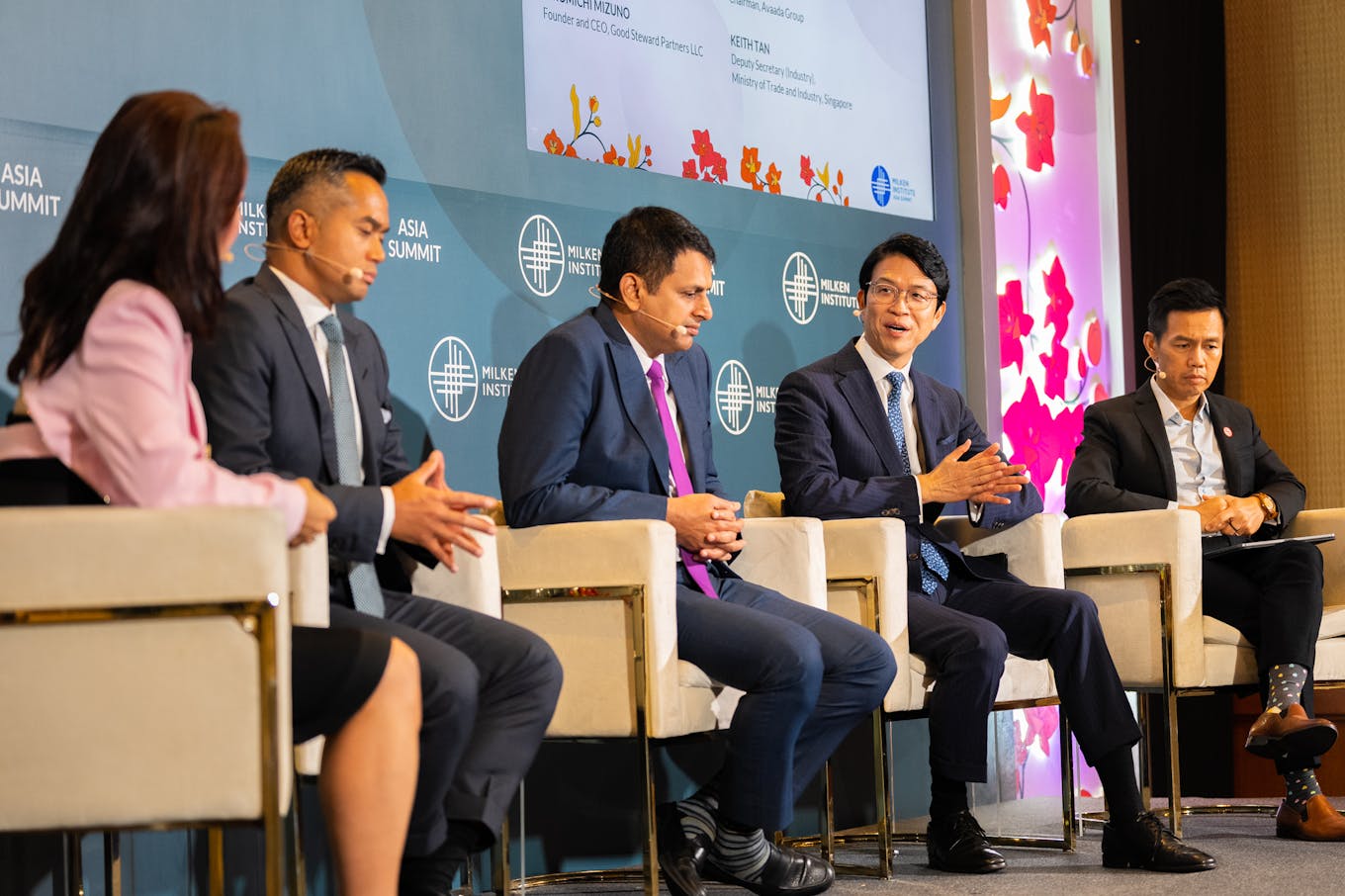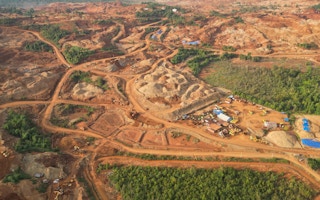From semiconductors to rare metals, no part of the global supply chain – including the green energy supply chain – has been left untouched as countries navigate the ongoing power tussle between China and the United States.
As Western countries seek to reduce their reliance on China – currently the indisputable leader in clean energy production – other Asian nations, such as India, Indonesia, South Korea and Japan, could play a much bigger role in the green energy supply chain, said Hiromichi Mizuno, founder and chief executive of consulting firm Good Steward Partners LLC, on Wednesday (13 September).
“China is going green and everybody else is trying to find a way to make the economy green without depending so much on China,” he said.
Mizuno, who is also a special advisor to the chief executive of MSCI, the world’s largest environmental, social and governance (ESG) rating company, as well as the former United Nations special envoy on innovative finance and sustainable investments was speaking on a panel discussion held at the Milken Institute’s Asia Summit in Singapore.

A panel on accelerating the transition to clean energy at the Milken Institute’s Asia Summit 2023. From left: Anindya Novyan Bakrie, chief executive and president director, Bakrie & Brothers; Vineet Mittal, chairman, Avaada Group; Hiromichi Mizuno, founder and chief executive, Good Steward Partners LLC; Keith Tan, deputy secretary (industry), Ministry of Trade and Industry, Singapore. Image: Milken Institute
Unlike what the name of the bill suggests, most of the US administration’s landmark US$369 billion “Inflation Reduction Act” (IRA) is about “trying to secure their supply chain for the green economy,” he said.
The IRA requires manufacturers to meet two criteria to receive the full US$7,500 electric vehicle (EV) tax credit. Firstly, 40 per cent of the critical battery minerals need to be extracted or processed in the US or one of its free trade agreements partners, like Mexico and Canada. Secondly, half of the battery components must be manufactured and assembled in North America.
The upstream supply chain for renewables – which China currently has a near monopoly on – refers to activities in the pre-production stage. This includes sourcing and transporting critical raw materials needed for the energy transition such as cobalt, lithium and nickel, which are all on US Department of Energy’s list of the most important minerals for the country’s energy needs.
China accounts for 60-70 per cent of the world’s cobalt, lithium and nickel processing as well as nearly 90 per cent of processed rare earth elements, such as dysprosium, neodymium, praseodymium and terbium, which are key building blocks of EVs and wind turbines. China’s dominance in critical minerals has been decades in the making, with Deng Xiaoping, the late Chinese leader who oversaw the country’s economic reform, declaring in 1992: “The Middle East has oil. China has rare earth metals.”
Just as oil was weaponised by oil-producing countries in the 1970s against nations that had supported Israel during the 1973 Arab-Israeli War, and again by Russia in 2022 against Europe over its support of Ukraine in the ongoing war, China’s control over the world’s rare earth metals is seen as a threat to its geopolitical rivals.
As countries find it increasingly risky to use Chinese-sourced materials, policymakers will focus on restructuring their supply chains, which could allow other Asian countries like India and Indonesia to play a more significant role in the global energy transition, especially in the upstream supply chain, suggested Mizuno.
Who stands to benefit from US-China rivalry?
Japan and South Korea were both early players in the development of EV battery technology, but leading EV battery manufacturers in both countries, including Panasonic and LG Chem, have lost ground to upstart Chinese battery makers such as BYD and CATL which have benefitted from generous government subsidies.
Mizuno implied that Japan and South Korea could be beneficiaries from the US-China rift. Both countries, widely regarded as geopolitical allies, have been courted by the US to be battery supply chain partners – a growing practice known as “friendshoring”.
Indonesia, which holds the world’s largest nickel reserves, is currently one of China’s top nickel ore suppliers. But it is also looking to position itself as a go-to alternative to China for EV battery production.
Another speaker on the panel, Anindya Novyan Bakrie, chief executive of Indonesian conglomerate Bakrie & Brothers, said that Indonesia can play a significant role in filling the gap in EV battery materials in Western markets.
Bakrie & Brothers – a long-time partner of Chinese automotive giant BYD, with interests in coal mining, media and property development – launched the Indo-pacific Net-zero Battery-materials Consortium (INBC) last December with Chinese energy firm Envision and Swiss miner Glencore.
The consortium plans to build Indonesia’s first net-zero industrial park in Indonesia on the island of Sulawesi, a key production site where miners have been accused of water pollution, land grabs and weak safety standards. By 2026, it aims to start producing low-carbon nickel components and producing 120 gigawatt-hour (GWh) worth of EV batteries per year to be sold to Britain and European markets.
“We will process battery materials to send it purely to the West,” Bakrie said.
Earlier this month, Indonesian President Joko Widodo proposed a critical minerals trade deal with the US when he met with Vice President Kamala Harris on the sidelines of the Asean Summit. But a deal has yet to been reached.
Vineet Mittal, chairman of Avaada Group, an Indian green energy developer, spoke on the same panel about how India has dramatically brought down the cost of solar power generation to Rs 2 (US$0.024) per kilowatt-hour (kWh), which is lower than the global weighted average cost of US$0.049 per kWh in 2022.
Mittal said that India is piloting “round the clock clean solutions”, such as floating solar panels with pumped hydro storage, which can be easily replicated at a competitive price, even in places without huge landmasses.
He also cited how the India-led International Solar Alliance, which counts 110 countries among its members, seeks to make the solar energy market – currently almost entirely reliant on China – more diverse and the cheapest source of electricity in most geographies through knowledge sharing.
Green subsidy race versus carbon taxes
The European Union, Japan and South Korea have since cranked up their own green subsidies to match those in the US and China, spurring billions of new investments into clean energy sectors.
Ideally, this sets off a virtuous cycle of lowering costs in less mature technologies that can benefit from large economies of scale.
However, a recent report by research firm BMI, a unit of Fitch Group, warned that green subsidies focused on developing domestic supply chains with a friendshoring approach, as opposed to a bilateral, multi-market approach, could push up the costs of low-carbon technologies and hinder their widespread implementation.
Given that the technologies needed for the energy transition are already available, Mittal argued that what the global commons needs is a common price on carbon. But he emphasised that it must be implemented in a way that is fair, so that people who are not responsible for causing ecological damage do not pay the price.
Mizuno, who previously served as the chief investment officer of the Japan Government Pension Investment Fund (GPIF), the world’s largest pension fund, also advocated for carbon pricing as a “game-changing” tool to shift the market, based on his experience experimenting with other methods, like changing the benchmark index for the GPIF portfolio or engaging with the government to enforce disclosures.
Despite most economists agreeing that putting a sufficiently high price on carbon is the most efficient way to tackle climate change, only 46 countries worldwide have started pricing carbon through taxes or emissions trading schemes, according to the International Monetary Fund. The international lender said that the current average carbon price of US$6 per tonne must rise to US$75 per tonne by 2030 to effectively limit global warming.
The introduction of a long-term, predictable carbon price could make it more financially viable and less risky for renewable energy investments in developing countries, since climate-related risks would be priced in, said Mizuno.
“At the end of the day, what we need is the companies, businesses or countries who are benefitting at the expense of others to pay for it,” he said.

















